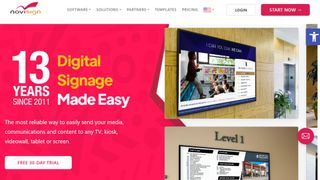Best digital signage software of 2025
Advertising and information delivery

The best digital signage software makes it simple and easy to advertise your services or display information.
The difference is that with digital signage you can display video, sound, graphics, animation, and more on monitors, projectors, and other multimedia devices.
But to really make the most of this clever technology, you’ll need the best digital signage software to accompany your hardware device, enabling you to control multiple screens remotely.
Digital signage software is a bit of a niche topic and this article could well be one of the first you’ve read on the technology. That’s why we’ve made it as simple as possible for you to learn about the best digital signage software available so you can make a decision on the right product for your business.
Note sure how to set it up? You can learn about improving digital signage installations with AV over IP technology.
We've also featured the best interactive kiosk providers.
The best digital signage software of 2025 in full:
Why you can trust TechRadar
Best affordable

1. TelemetryTV
Reasons to buy
Reasons to avoid
TelemtryTV is a great signage software option for users of varying budgets, with a free version for one user limited to one device. The Essential plan is designed for mid-sized audiences and is charged per device for up to three users. The Enhanced plan caters for 5 users and there is also a custom option.
On sign-up, you’re encouraged to download a desktop app for your OS. Alternatively, you can access the interface through your browser.
The standard browser interface is impressive. It’s well-designed, authoritative, and clearly signposted.
The home page is packed with video tutorials to help you get started, but the interface is fairly self-explanatory once you click the Playlist section.
That said, technologically savvy users will get much more from the platform. It is possible to create basic displays using the built-in editor, but more advanced users can use the technology to achieve very professional results.
Best for enterprises

2. NoviSign
Reasons to buy
With over 20,000 clients including enterprise customers like Disney and Hilton, NoviSign is a big deal in the digital signage software industry.
NoviSign enables users to produce bespoke, high-end displays using pre-made, customizable templates. The templates are ordered by sector, like hospitality or retail, and make it very easy to create a professional display regardless of technical ability.
The interface is very simple to navigate and split into three distinct sections, Creatives, Playlists, and Screens. Information is easily integrated into displays via RSS feeds, widgets, and apps, while all text and imagery are fully customizable too.
We were particularly impressed by the platform’s scheduler, or Playlist function, an intuitive system that enables users to pull in content and arrange when and where it will be played, much as you would on Spotify or iTunes.
NoviSign has four packages to choose from, starting with the standard Business plan, costing $18 per month when billed annually. This plan provides 1 user with 500mb of storage and a 100 MB max file upload.
There is a free 30-day trial to test the service before you commit financially.
Best for ease-of-use

3. OnSign TV
Reasons to buy
Reasons to avoid
OnSign TV is easy-to-use digital signage software compatible with multiple operating systems including Android, Windows, Chrome OS, macOS, Phillips, Linux Samsung SSP, and more.
OnSign TV provides a comprehensive list of compatible players and the hardware required for them. Our advice would be to study this first or search for your existing equipment before getting started.
Once set up, the technology is incredibly user-friendly. OnSign TV is powered by a wide range of free apps that display a great deal of information, from sports results to the local weather forecast. There is also the option to create your own apps in HTML5 or request the platform’s developers to do it for you.
The interface works on a drag-and-drop basis, so you can pull in the content you want, whether that be an app or other media, and schedule your monitor to play it.
Best cloud-based

4. Yodeck
Reasons to buy
Reasons to avoid
Yodeck is marketed as a digital signage software solution that was “born and raised on the Cloud.” In theory, this should mean that with everything available on-demand, the service is quick and reliable, and that’s just how Yodeck markets itself.
However, in order to run its single-monitor “free” service, you are required to buy a Yodeck Player - based on a Rasberry Pi. Either that or run Yodeck on your monitor for free by configuring an existing Rasberry Pi, something that will baffle most first-time users, and which is by no means quick.
Alternatively, annual plans start at a monthly rate per screen, and subscribers receive an unlimited number of players for free.
The platform has all the basic features you’d expect like video and audio compatibility, as well as a number of widgets enabling you to stream content from third-party providers, including the BBC and CNN.
Yodeck’s interface is self-explanatory and scheduling monitors is particularly simple, with existing templates already in place. We were a little surprised to see a world map taking up so much room on the Dashboard display, though.
Yodeck has three plans available: Standard, Pro and Enterprise. The lowest tier Standard plan offers image, video, audio and document files, live streams, YouTube and web pages and free stock images & video. The price is around $8 per screen per month.
You can try any of their plans for free for a single screen.
Best for hardware

5. Viewneo
Reasons to buy
Reasons to avoid
Viewneo combines its software with optimized hardware solutions, including AI-powered sensor technology to determine when your monitors display messages.
A modular system, Viewneo grows at the pace of your business, and it’s possible to add and remove components depending on the size and complexity of the displays you require.
The software includes Pixabay integration, which gives you access to over two million images, design templates, numerous plugins for social media, weather, a news feed, and more. You’ll also find comprehensive reports and analytics enabling you to use the technology to measure interactions with your messaging.
The CMS is very clear and easy to use, with minimal tabs and subcategories, so first-time users shouldn’t struggle to get started. Finally, although the platform pushes its own hardware, the software is compatible with other players, including the Amazon Fire TV Stick and Google Chromecast.
We've listed the best large format displays.
Digital signage software FAQs
Which digital signage software is best for you?
When deciding which software to choose, first have a clear idea of what your actual needs are, as different digital signage providers may offer a range of different tools according to the type and purpose of displays being used. So do ensure you have a good idea of which features you think you may require for your own purposes.
How we tested the best digital signage software
To test for the best digital signage software we first set up an account with the relevant provider, then we tested the service to see how the software could be used for different purposes and in different situations. The aim was to push each digital signage platform to see how useful its basic tools were and also how easy it was to get to grips with any more advanced tools.
Read how we test, rate, and review products on TechRadar.
Get in touch
- Want to find out about commercial or marketing opportunities? Click here
- Out of date info, errors, complaints or broken links? Give us a nudge
- Got a suggestion for a product or service provider? Message us directly
Are you a pro? Subscribe to our newsletter
Sign up to the TechRadar Pro newsletter to get all the top news, opinion, features and guidance your business needs to succeed!
Kieron is a freelance science and technology journalist with more than a decade of experience writing for magazines in print and online. Today, his focus is on cybersecurity, blockchain, and emerging tech.
